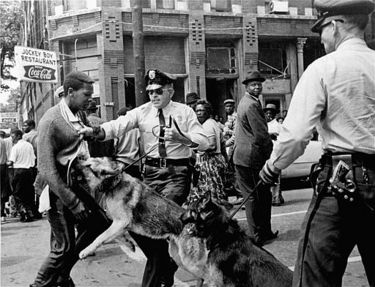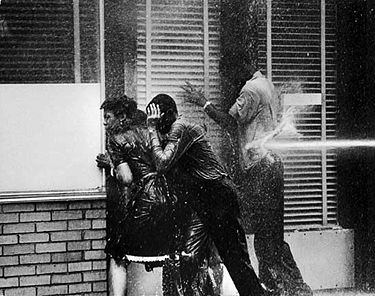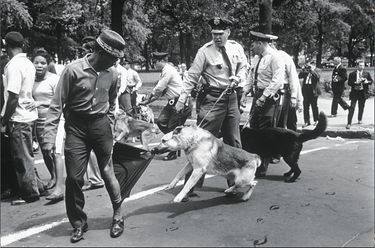Police dogs and firehoses
Police dogs and firehoses is, for most of the world, the image of Birmingham made by Bull Connor and the Birmingham Police Department during the Birmingham Campaign of the African American Civil Rights Movement.
While both weapons had been used before to control protesters, the images most often seen by the general public were recorded on May 3, 1963, the second day of the Children's Crusade when thousands of African American schoolchildren volunteered to join the non-violent protests, and likely go to jail, as a demonstration against segregation. On that second day Connor realized that the jails could hold no more people, so the tactics of the police changed from mass arrests to keeping protesters out of the downtown business area.
Crowd control
Over a thousand students gathered at 16th Street Baptist Church by mid day on May 3, leaving in groups to walk across Kelly Ingram Park toward Birmingham City Hall and the downtown business district chanting, "We're going to walk, walk, walk. Freedom...freedom...freedom."1. As the demonstrators left the church they were warned to stop and turn back, "or you'll get wet."2. When they continued, Commissioner Connor ordered the city's fire hoses turned on the children. The first soaking mist sent many of the demonstrators fleeing, but a remnant of 20 or so stood their ground. As the water pressure was increased, boys' shirts were ripped off with the force of the water, and young women were lifted off their feet and over the tops of cars. When the students fell or crouched down, the blasts of water rolled them down the asphalt streets and concrete sidewalks. Connor allowed white spectators to push forward, shouting, "Let those people come forward, sergeant. I want 'em to see the dogs work. Look at those niggers run!"3.
Bystanders who had gathered to see the standoff, but had not been participating in demonstrations, were buoyed by the singing and shouted cheers to the students. When the hoses were turned on, however, the bystanders began to yell, and some threw rocks and bottles at the police. Connor ordered police K-9 units to disperse the crowds. Southern Christian Leadership Conference project coordinator James Bevel darted in and out of the crowds warning them, "If any cops get hurt, we're going to lose this fight."4. One bystander, Walter Gadsden, was caught by Associated Press photographer Bill Hudson in the clutches of a policeman while a dog lunched for his abdomen. The resulting photograph became an emblem of brutal police tactics used against dignified peaceful marchers. Ironically Gadsden, a member of the Scott family that published the Birmingham World, was not a protester. He and his family were highly critical of King and his movement and Gadsden later took the attack as a signal that he was hanging around with the wrong kind of people.
By 3:00, the protest was over. Protesters left the churches and went home as police cleared blockades off the streets for traffic again. That evening King told worried parents in a crowd of a thousand, "Don't worry about your children who are in jail. The eyes of the world are on Birmingham. We're going on in spite of dogs and fire hoses. We've gone too far to turn back."5.
Publicity
Television cameras broadcast the scenes of fire hoses knocking down schoolchildren and dogs attacking individual demonstrators with no means of protecting themselves, to the nation. Where support for King and the SCLC from the black community had been disjointed prior to May 3, the media coverage created a situation where, "the black community was instantaneously consolidated behind King," according to attorney David Vann6.. New York Senator Jacob K. Javits, horrified at the lengths the Birmingham police were going to protect segregation, declared, "the country won't tolerate it," and pressed Congress to pass a civil rights bill7.. Similar reactions were reported by Kentucky Senator Sherman Cooper, and Oregon Senator Wayne Morse, who compared Birmingham to South Africa under Apartheid8.. A New York Times editorial called the behavior of the Birmingham police "a national disgrace."9. The Washington Post editorialized, "The spectacle in Birmingham...must excite the sympathy of the rest of the country for the decent, just, and reasonable citizens of the community, who have so recently demonstrated at the polls their lack of support for the very policies that have produced the Birmingham riots. The authorities who tried, by these brutal means, to stop the freedom marchers do not speak or act in the name of the enlightened people of the city."10. President Kennedy sent Burke Marshall to Birmingham to try to negotiate a truce.
The images were also used by the Soviet press as evidence of totalitarianism and brutality in the United States, which regularly accused the USSR of stifling freedom. Over time they have been republished in countless histories, textbooks and magazine articles as icons of the battles of Civil Rights in the 1960s and also as evidence in discussing the role of the press and photojournalists in reporting stories and shaping public opinion.
For residents of Birmingham the images have become a shameful reminder of an ugly episode in the city's past. Clearly Birmingham has overcome the overt and publicly-sanctioned racial hatred which allowed such weapons to be deployed against peaceful protesters just as much as it has put its segregation laws to rest. However, much disagreement remains on the role images of history such as these should play in contemporary Birmingham. Many wish that they would be entirely forgotton while others see them as matters of continuing importance as racial tensions persist in Birmingham and across the world.
Notes
- Washington Post - May 4, 1963
- Newsweek - May 13, 1963
- TIME - May 10, 1963
- Newsweek - May 13, 1963
- TIME - May 10, 1963
- Hampton - 1990
- Javits in New York Times - May 5, 1963
- New York Times - May 7, 1963
- New York Times - May 5, 1963
- Washington Post - May 5, 1963
References
- Haily, Foster (May 4, 1963) "Dogs and Hoses Repulse Negroes at Birmingham." New York Times
- "Fire Hoses and Police Dogs Quell Birmingham Segregation Protest" (May 4, 1963) Washington Post
- "Outrage in Alabama" (May 5, 1963) New York Times
- "Javits Denounces Birmingham Police" (May 5, 1963) New York Times
- "Violence in Birmingham." (May 5, 1963) Washington Post
- "Birmingham's use of dogs assailed." (May 7, 1963) New York Times
- "Dogs, Kids and Clubs" (May 10, 1963) TIME magazine
- "Birmingham USA: 'Look at Them Run'" (May 13, 1963) Newsweek
- Hampton, Henry, ed. (1990) "Birmingham, 1963." Voices of Freedom: An Oral History of the Civil Rights Movement from the 1950s to the 1980s. New York, New York: Bantam Books
- Birmingham campaign. (October 17, 2007)[1]. Wikipedia - accessed October 18, 2007.


